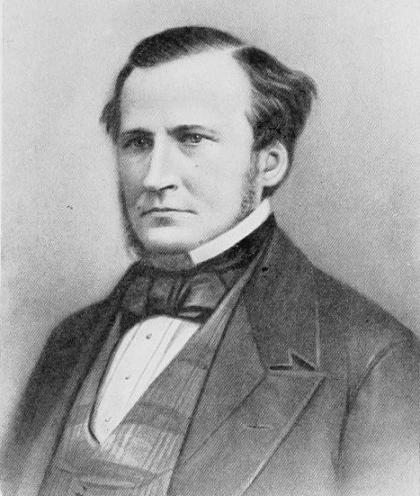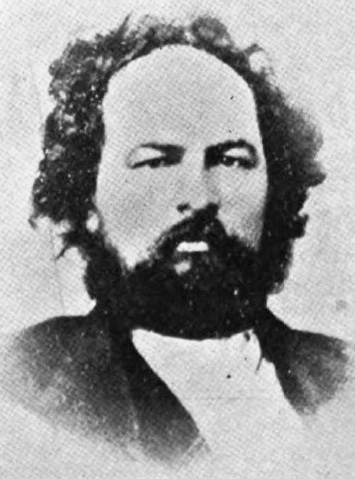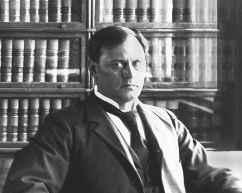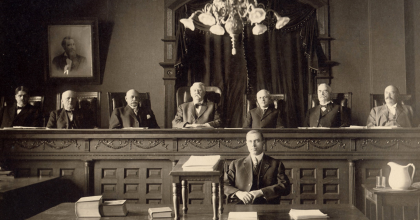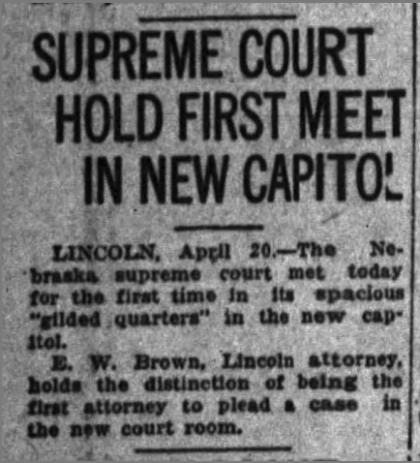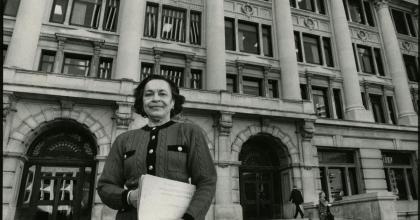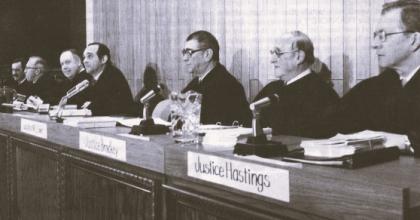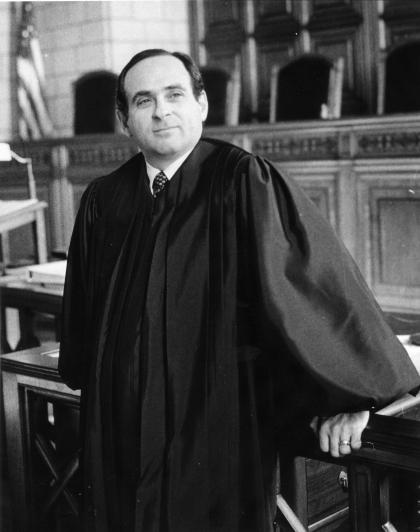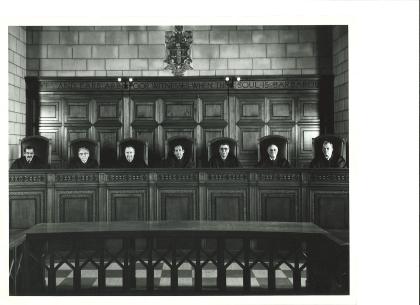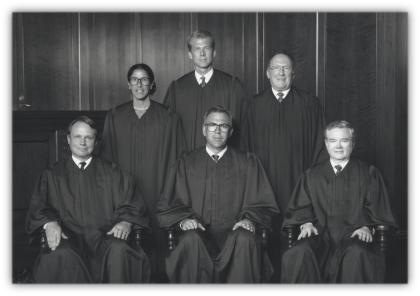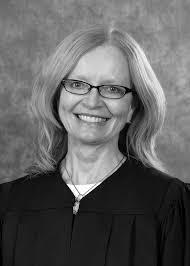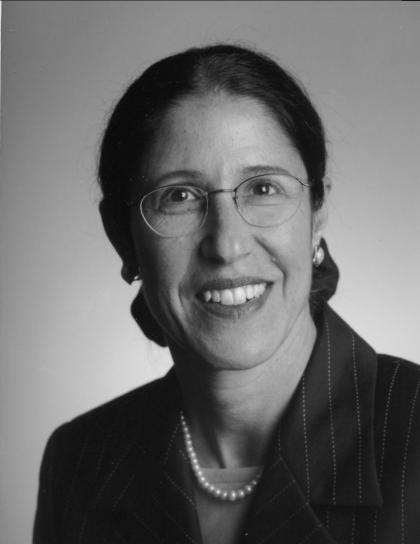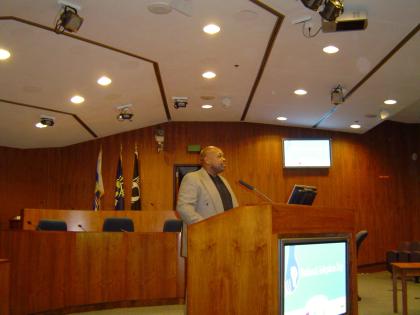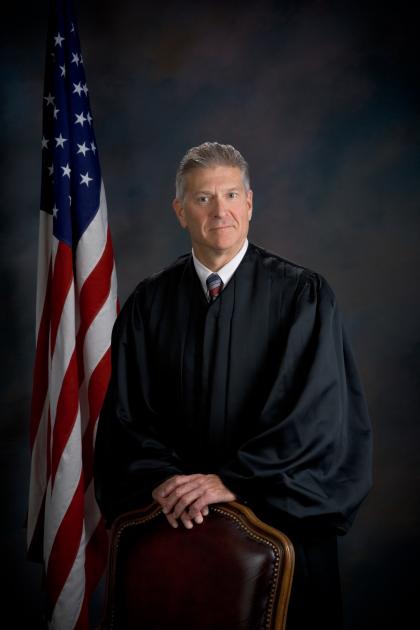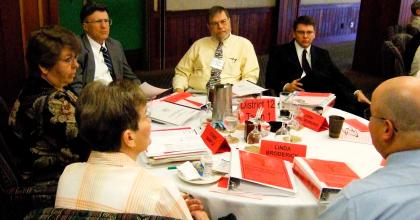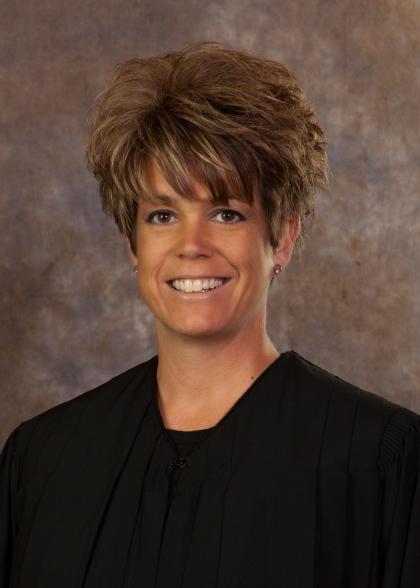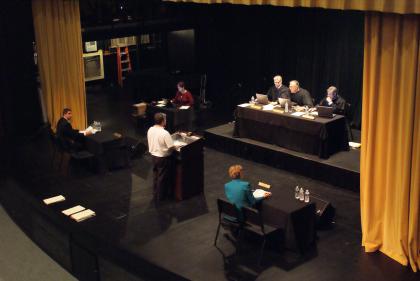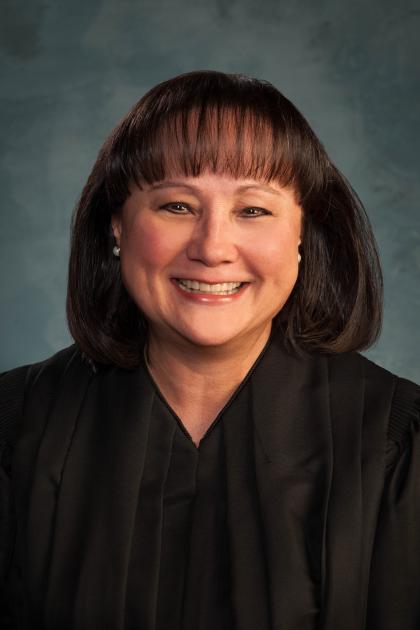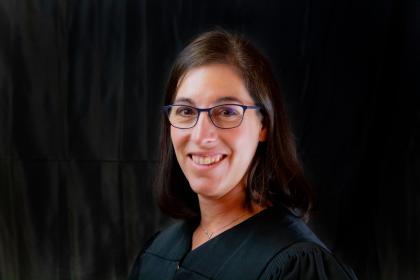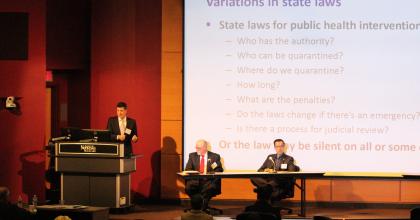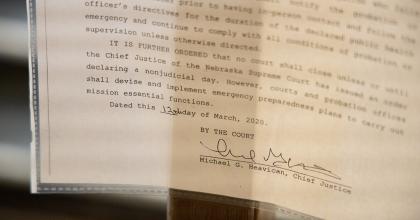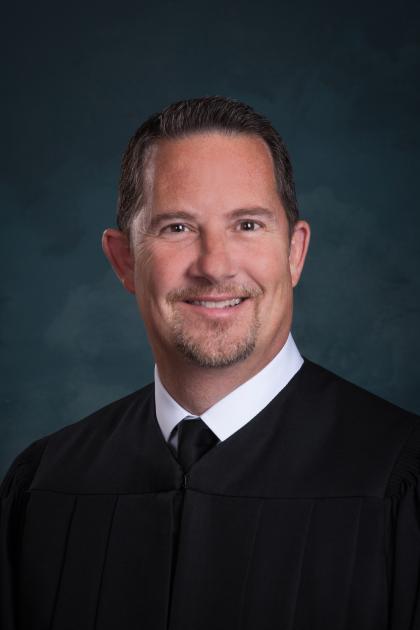History of the Nebraska Judicial Branch
Rev. Nov 2024
First Chief Justice of the Territorial Court
Fenner Ferguson, first Chief Justice of the Territorial Nebraska Supreme Court, served 1854-1859. Nebraska's original Supreme Court, referred to as the Territorial Supreme Court, was established following the Kansas–Nebraska Act. Fifteen male judges comprised the bench of the Territorial Supreme Court. https://en.wikipedia.org/wiki/Fenner_Ferguson
- 1854-1859: First Judge of the territorial court: Fenner Ferguson (blue book)
- The Nebraska Supreme Court had its origin in the Organic Act, which created the Nebraska Territory on May 30, 1854. This act declared that the Supreme Court shall consist of a chief justice and two associate judges.
Nebraska State Library Established
The Nebraska State Library is the oldest public library in the state. In 1855 (before the territory of Nebraska became a state), Congress appropriated monies to the territory of Nebraska for library resources. In 1871, the Nebraska Legislature enacted a statute specifically relating to the creation of the Nebraska State Library. The State Library was separated into two sections, law and miscellaneous. The Legislature named the Clerk of the Supreme Court as the librarian and the judges of the Nebraska Supreme Court as the board of directors of the law collection. The Secretary of State was the librarian for the miscellaneous collection and the Governor, Secretary of State, and Auditor as the board of directors for the miscellaneous collection. Both collections were put under the supervision of the Supreme Court in 1913.
Three-Member Nebraska Supreme Court Established through State Constitution
The first state constitution, adopted in 1866, provided for a supreme court to consist of a chief justice and two associate justices, elected for six-year terms. They were required to hold one term of court annually at the seat of government, and the state was divided into three judicial districts. In addition to the duty of hearing cases on appeal, rendering decisions, and preparing opinions in the Supreme Court, each justice acted as trial judge in the district court, which was the court of general law and equity jurisdiction. During the nine years this system prevailed, the state had only the Union Pacific main line and a few other short lines of railroad, touching but a few counties out of the territory now comprising ninety-three counties. It is recorded that some of the judges were required to travel ten thousand miles in a year going to and from their trial courts, most of which had to be done by stagecoach, by buckboard, or on horseback.
Midnight Ride of the State Library from Omaha to Lincoln – moving the Territorial Library
The move of the territorial library began with a late-night trip to Omaha and the office of Silas A. Strickland, where the Auditor of Public Accounts, John Gillespie, ordered contents of the territorial library removed. Gillespie hired J.T. Beach of Lincoln to travel the many miles in search of the governmental records of the time. The year was 1868. The telling of the story of the State Library’s Midnight Ride from Omaha to Lincoln is written in the April 26, 1959, Sunday Lincoln Journal Star.
Chief Justice George B. Lake Begins Term of Office
1873-1878, 1882-1884 {Served as Associate Term of Office 1867-1873, 1878-1882}
Chief Justice Daniel Gantt Begins Term of Office
1878 {Served as Associate Term of Office 1873-1878}
Chief Justice Samuel Maxwell Begins Term of Office
1878-1882, 1886-1888, 1892-1894 {Served as Associate Term of Office 1873-1878, 1882-1886, 1888-1892}
Chief Justice Amasa Cobb Begins Term of Office
1884-1886, 1890-1892 {Served as Associate Term of Office 1878-1884, 1886-1890}
Chief Justice Manoah B. Reese Begins Term of Office
1888-1890, 1909-1915 {Served as Associate Term of Office 1884-1888, 1908-1909}
First Native American Judge Elected to Bench
Hiram Chase became the first Native American judge in Nebraska when he was elected county judge of Thurston County. He served one term. Chase was born on the Omaha reservation on September 9, 1861. His father, Hiram Chase, Sr., was a government inspector, and his mother, Nunzainza, was the granddaughter of Wahnookega, chief of the Omaha people.
Chief Justice T.L. Norval Begins Term of Office
1894-1896, 1900-1902 {Served as Associate Term of Office 1890-1894, 1896-1900}
Chief Justice Alfred M. Post Begins Term of Office
1896-1898 {Served as Associate Term of Office 1892-1896}
Chief Justice T.O.C. Harrison Begins Term of Office
1898-1900 {Served as Associate Term of Office 1894-1898}
Chief Justice John J. Sullivan Begins Term of Office
1902-1904 {Served as Associate Term of Office 1898-1902}
Chief Justice Silas A. Holcomb Begins Term of Office
1904-1906 {Served as Associate Term of Office 1900-1904}
Chief Justice Samuel H. Sedgwick Begins Term of Office
1906-1908 {Served as Associate Term of Office 1902-1906, 1910-1919}
Chief Justice John B. Barnes Begins Term of Office
1908-1909 {Served as Associate Term of Office 1904-1907, 1909-1917}
Supreme Court Expanded to Seven Judges
The Nebraska constitution was amended in 1908 to include a bench of six associate justices and one chief justice of the Nebraska Supreme Court.
First Justices of the Seven–Member Nebraska Supreme Court:
- Manoah B. Reese, Chief Justice, 1909-1915 (serving second term)
- John B. Barnes 1904-1917
- Charles B. Letton 1906-1925
- James R. Dean 1909-1910, 1917-1935
- Jesse L. Root 1909-1911
- Jacob Fawcett 1909-1917
- William B. Rose 1909-1943
Through a joint resolution, in 1908 the House and Senate approved a constitutional amendment:
- Supreme Court to consist of 7 judges
- Judges elected by voters of the state at large for 6-year terms
- Governor to appoint 4 judges, creating a 7-member court
- Chief Justice to serve as chief during all the term for which elected (no rotation of chief justice position)
- Set the salaries of the Supreme Court at $4,500, and the district court judges at $3,000, payable quarterly
Nebraska Workmen’s Compensation Act
Legislation establishing a system for resolving claims of workplace injuries was first enacted in Nebraska in 1913 with the adoption of the Nebraska Workmen’s Compensation Act (the Act). From then until 1917, the Act was administered by the several state district courts. In 1917, the Nebraska Legislature created the Compensation Division within the Department of Labor and the commissioner of labor was designated compensation commissioner.
Chief Justice Conrad Hollenbeck Begins Term of Office
1915 {Died in office after less than one month of service}
Chief Justice Andrew M. Morrissey Begins Term of Office
1915-1927
Chief Justice Charles A. Goss Begins Term of Office
1927-1938
Three-Judge Workmen’s Compensation Court Designated
The 1935 Legislature established the three-judge Workmen’s Compensation Court and transferred Compensation Division functions to the court. That change was made to ensure stability through longer-tenured judges not subject to political changes and to provide a degree of specialization and expertise in a technical area.
Chief Justice Robert G. Simmons Begins Term of Office
1939-1963
Separate Juvenile Courts established in Nebraska
The people of Lancaster and Douglas Counties voted to establish separate juvenile courts as adopted by the 1959 Legislature under LB 127 and voted on by the electors in Lincoln and Omaha on November 8, 1960. Nebraska’s remaining counties hear juvenile matters in county courts. The juvenile courts have the same jurisdiction and procedures as the county courts when acting as juvenile courts. Seward L. Hart (Douglas County) and Wilfred W. Nuernberger (Lancaster County) became the first judges of the separate juvenile courts.
Merit Plan for Judicial Selection Adopted
The Merit Selection Plan for judges was passed by the voters in November 1962. Merit Selection is the judicial selection system that best ensures that qualified individuals reach the bench without the influence of politics and money on the selection process. Originally, the plan applied only to the selection of judges to the Supreme Court and district courts. In 1974, this merit plan was statutorily extended to the selection of county court judges, and in 1990, it was applied to the judges of the newly-created Nebraska Court of Appeals. With the plan came the establishment of Judicial Nominating Commissions.
Chief Justice Paul W. White Begins Term of Office
1963-1978
Commission on Judicial Qualifications Established
Voters approved an amendment to the Constitution establishing the Commission on Judicial Qualifications in 1966. In 1967, the Legislature created the Commission pursuant to Article V, Sections 28 to 31 of the Nebraska Constitution. The goal of the judicial discipline process through the Qualifications Commission is to protect the public, the profession, and our system of justice from unethical conduct.
Supreme Court Administrative Authority and County Court Consolidation
In 1970 the judicial article of the state constitution was amended resulting in several significant changes in the state court system. The amendment gave the Nebraska Supreme Court general administrative authority over all Nebraska courts, eliminated the constitutional basis for the justice of the peace, consolidated the local courts and other courts of limited jurisdiction to form a uniform county court system, and created the position of state court administrator.
First Female and First African American Judge Appointed
Judge Elizabeth “Betty” Davis Pittman was appointed by Gov. J. James Exon as a municipal court judge for the City of Omaha in 1971. She became the first woman and first African American person to be a judge for the State of Nebraska when she was appointed, serving from 1971 until 1986 on the Omaha Municipal Court.
Restructuring of Nebraska Trial Court System in 1970: Supreme Court Authority and County Court Consolidation
The County Courts, Justice of Peace Courts, and Police Magistrate courts were combined in 1972. The present county court system (established in 1972) combines the previous functions of the 93 county courts, several hundred police courts, and several hundred justices of the peace. The 1972 change was the first major restructuring of Nebraska’s courts of limited jurisdiction since statehood was attained.
Betty Peterson Sharp First Female Appointed to District Court Bench
1972-1976
Colleen R. Buckley Appointed First Female Separate Juvenile Court Judge
1973-1994
Separate Juvenile Court Established in Sarpy County
The people of Sarpy County voted to establish a separate juvenile court in 1976. Judge William D. Staley was first judge to take the bench.
Chief Justice Norman Krivosha Begins Term of Office
1978-1987
First Supreme Court Argument Session Held at Law School
Supreme Court held court sessions at Creighton Law School in 1979, establishing an ongoing tradition with both Nebraska Law Schools. In 1980 the Court sat at the University of Nebraska College of Law at the invitation of the Student Bar Association in celebration of Law Day.
First Chief Justice State of the Judiciary Address to the Legislature
The 86th Nebraska Legislature passed a resolution inviting Chief Justice Norman Krivosha to address the Unicameral annually regarding the condition of the state's courts. Chief Justice Krivosha gave his first address in 1979.
Municipal Courts Merged into State Court System
Effective July 1, 1985, municipal court employees were transferred into the county court system, and municipal court probation employees were transferred into the state probation system.
Renaming of Compensation Court
Workmen’s Compensation Court underwent name change to Workers’ Compensation Court through LB 811 (1986).
Probation Moved Under Authority of Supreme Court
The Legislature placed probation for district courts under the authority of the Nebraska Supreme Court effective July 1, 1986. LB 529 called for the Nebraska Probation System Committee to serve as an advisory committee until its duties were taken over by the Nebraska Probation Advisory Committee on July 1, 1988.
Chief Justice William C. Hastings Begins Term of Office
1987-1995 {Served as Associate Term of Office 1979-1987}
Nebraska Court of Appeals, Intermediate Appellate Level Court, Established
The Court of Appeals was established September 6, 1991, as a result of a constitutional amendment approved by voters in the 1990 general election. The 1991 Legislature passed enabling legislation that determined the specifics of the court. The court was created to alleviate the increasing backlog of appeals pending before the Supreme Court and, ultimately, to expedite appellate review of decisions of lower courts and tribunals.
Nebraska Court of Appeals Leadership, First Judges
Judge Richard Sievers took the bench of the Court of Appeals on January 7, 1992, and served as the Court’s first chief judge until December 1995. First judges of the Court include:
- William M. Connolly
- Edward E. Hannon
- John F. Irwin
- Lindsey Miller-Lerman (Only woman appointed to sit on the newly established Nebraska Court.)
- Richard D. Sievers
- John F. Wright
Judicial Resources Commission Created
Judicial Resources Commission is established to determine whether a judicial vacancy exists following a trial judge’s departure from the bench. The Commission is also tasked with recommending changes in the number of judgeships, judicial districts, or boundaries based on an analysis of judicial workload statistics.
Trial Court Judicial Districts Reduced
The number of judicial districts reduced from 21 to 12 with LB1059 in 1992.
Office of Dispute Resolution
The Office of Dispute Resolution (ODR) established in 1992, and six ODR centers are approved. The structure of the system was created through the Legislature in 1991.
Chief Justice C. Thomas White Begins Term of Office
1995-1998 {Served as Associate Term of Office 1977-1995}
First Drug Court Begins Operation in Omaha
The Douglas County Adult Drug Court, a division of the District Court of Nebraska, 4th Judicial District, became the first Drug Court in the state in April 1997 and the 13th in the nation. After stepping down from the District Court in 1997, Judge James Murphy established the Drug Court in Douglas County.
Chief Justice John V. Hendry Begins Term of Office
1998-2006
First Woman Judge to Serve on the Supreme Court Bench
Justice Lindsey Miller-Lerman, the first woman on the Nebraska Supreme Court, took the bench on September 1, 1998, replacing retiring Justice D. Nick Caporale. She was originally appointed to the Court of Appeals, at the time she was the only female judge to be appointed to the Court of Appeals bench.
Mediation Begins in Nebraska
Mediation was introduced in Nebraska with the passage of the 1988 Farm Mediation Act (§§ 2-4801 thru 2-4815). Statewide community-based mediation efforts began in the 1980s in Nebraska. The financial crisis in agriculture in the early 1980s gave rise to the farm crisis hotline in 1984, and in 1988 to the Nebraska Farm Mediation Act.
Supreme Court’s Inaugural Website Posted
The Supreme Courts first website was unveiled on May 1 (Law Day) 1999. Dedicated to the judicial branch, the site featured links to main Judicial Branch offices, sections for Supreme Court schedules (call), trial court information, and resources for the public.
Distinguished Judge Awards Developed
Chief Justice John V. Hendry established the Distinguished Judge Awards in 1999. The first recipients were Judge Robert O. Hippe, District Judge, 12th Judicial District, for improvement of the judicial system for his work editing the Nebraska Judges Bench Book and the development of divorce education classes in his district; and Retired Judge James Murphy, District Judge, 4th Judicial District, for service to the community for his efforts to establish Nebraska’s first drug court.
Legislative Court Visits Begin
Supreme Court established the Legislative Court Visit program introducing new state senators to visit their local courtrooms to observe first-hand how their local courts operate. The ongoing program is offered to every new legislator during their first year in office.
First National Adoption Saturday Held in Omaha
National Adoption Saturday began in Douglas County Juvenile Court by Judge Wadie Thomas in 1999. During the 20-year anniversary celebration in 2019, Judge Thomas was quoted saying, “It’s my pleasure to be back to share in this wonderful event.” He said, “It was my privilege to be involved in the very first National Adoption Day in Nebraska, which was specifically Douglas County. It is one of those occasions designed to bring media attention to the fact that more foster and adoptive homes are needed.” Many courts in Nebraska followed by creating their own celebrations later adopted by the “Through the Eyes of the Child” initiative teams.
Supreme Court Technology Committee Formed
Chief Justice John V. Hendry created the Supreme Court Technology Committee in November 2000, cochaired by Judges John Irwin and Alan Brodbeck.
Counsel for Discipline Moves Inside the Nebraska Judicial Branch
The Office of the Counsel for Discipline moved from the Nebraska State Bar Association to the Nebraska Judicial Branch on January 1, 2002, with Dennis Carlson serving as the Counsel for Discipline.
Mandatory Judicial Branch Education Funding Passed through Legislature
Judicial education became mandatory for Nebraska judges and probation and court staff following the establishment of legislative funding. In 2005, judicial branch education staff were hired, and in 2006, the program was designed and launched. The funding for the mandatory judicial education program came from “dollar filing fees,” meaning a dollar from every filing fee received was directed towards the program.
Pro Se Committee Established
The now named Self-Represented Litigation Committee was created in 2003 to engage in continuing analysis and study of the challenges that self-represented litigation poses for court staff, the judiciary, and the practicing bar; to continue assessment of the challenges to the right of self-representation that the judicial system currently presents; to propose solutions or improvements in response to such challenges to the Nebraska Supreme Court; and to implement the recommendations of the Self-Represented Litigation Committee that the Nebraska Supreme Court approves.
Commission on Children in the Courts
The Nebraska Supreme Court establishes the Commission on Children in the Courts in 2004 to study and recommend appropriate steps for the judicial system to undertake to ensure that the courts are as responsive as possible for children who interact with or are directly affected by the courts.
Chief Justice Michael G. Heavican Takes Bench in October
Michael G. Heavican took office as Chief Justice of the Nebraska Supreme Court in October 2006, replacing John V. Hendry. Heavican is the second-longest serving Chief Justice, retiring in October 2024 after 18 years of service.
Through the Eyes of the Child Initiative
An outgrowth of the Commission on Children in the Courts, the Through the Eyes of the Child Initiative arose from a statewide children’s summit held in September 2006 and planned by Chief Justice John V. Hendry. The name is to remind adults to consider every decision and every action with the immediacy of a young child. Judges, lawyers, and social service workers across the State have banded together to understand our system in a timeframe appropriate for a six-year-old.
Recodification of Nebraska Court Rules
Rules of the Nebraska Supreme Court were recodified and posted to the Judicial Branch Website in 2008. The project was completed by former Judge Robert Hippe of Scottsbluff and Reporter of Decisions office via Dorrene Brown Butterfield.
Mandatory Lawyer Continuing Legal Education
Nebraska Supreme Court instituted court rule requiring ten hours of Mandatory Continuing Legal Education for Lawyers. Supporting the rule, the Court appointed the Mandatory Continuing Judicial Education Advisory Committee.
College Campus Initiative Created by Nebraska Court of Appeals
Nebraska Court of Appeals established their College Campus Initiative in 2012, holding two panels of arguments at Peru State College in Peru, NE. The Court annually holds court arguments on college campuses throughout Nebraska near Constitution Day as a way of bringing the judicial branch to young people.
Public Guardianship Act Established in Judicial Branch
The Nebraska Legislature passed the Public Guardianship Act in 2014 through LB 920. The Act states, “The Legislature intends that establishment of the Office of Public Guardian will provide services for individuals when no private guardian or private conservator is available. The office is housed in the Judicial Branch.
Online Opinions Announced as Official Record
Online opinions for Nebraska Appellate Courts designated as official opinions in 2016.
Majority of Sitting Judges on Nebraska Supreme Court Female
“Quietly, with no fanfare, the Nebraska Supreme Court reached a historic, if temporary, milestone earlier this month when a majority of the sitting judges were female,” according to a January 31, 2016, article in the Omaha World-Herald.
Supreme Court Justices Lindsey Miller-Lerman and Stephanie Stacy were joined by Court of Appeals Judge Riko Bishop and two male judges to hear oral arguments on a January 6, appeal involving a claim against the state.
First High School Argument Session Held by Nebraska Supreme Court
Nebraska Supreme Court establishes education and outreach program using argument sessions in Nebraska High Schools. The first traveling arguments were held at Omaha Central High on March 31, 2016. Program eventually expanded to include multiple high school visits per year -- one in Omaha in conjunction with Creighton Law School arguments, and one in greater Nebraska in conjunction with Law Day.
First Native American Judge Appointed in Nebraska
Judge Andrea Miller took the bench in 2017 as the first Indigenous female judge in Nebraska. Miller is appointed to the Scotts Bluff District Court bench.
Cameras in County and District Court Courtrooms
Rules for Expanded News Media Coverage in Nebraska Trial Courts become effective in March 2017 allowing news stations to take video and still photographs in trial courts.
Supreme Court Establishes Access to Justice Commission
The Supreme Court’s Access to Justice Commission was established in 2017 with the mission to identify barriers to equal access in Nebraska and to recommend and coordinate effective solutions so that all court users have equal access to swift, fair justice.
Nebraska Hosts National Summit on Pandemic Preparedness
Participants from the nation’s state courts attended a Summit on Pandemic Preparedness at the University of Nebraska Medical Center (UNMC) on May 22 – 24, 2019. The summit, hosted by Nebraska Chief Justice Michael G. Heavican, brought together state court chief justices and other court leaders, health officials, and members of the legislative and executive branches to discuss ways in which a pandemic outbreak will be addressed by the court system and other entities when the need arises.
First COVID-19 Order Issued by Chief Justice
Chief Justice Michael G. Heavican issued an Administrative Order on March 12, 2020, regarding the Novel Coronavirus and COVID-19, which announced a state-wide Emergency Preparedness Plan for all state trial courts and all probation offices. The Chief Justice’s Administrative Order also set out requirements for counsel, parties, and probation clients who may have been exposed to or diagnosed with COVID-19 regarding attendance at court hearings or trials, depositions, and/or probation supervision meetings.
First Installation of Supreme Court-Funded Technology Upgrade
Cedar County was the first of nearly 200 trial court courtrooms to enhance audio-visual equipment through the Nebraska Judicial Branch courtroom technology upgrade project. Following the Cedar County installation, courthouses and judicial centers across the state underwent a similar transformation based on their needs and existing technology infrastructure.

